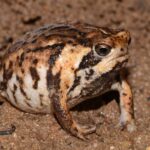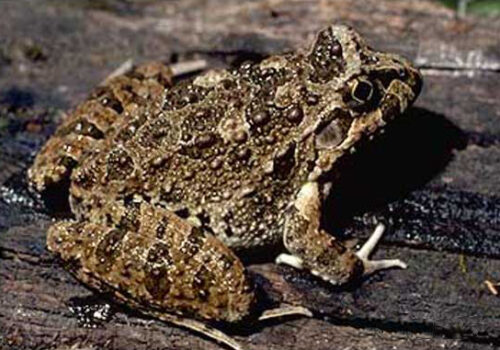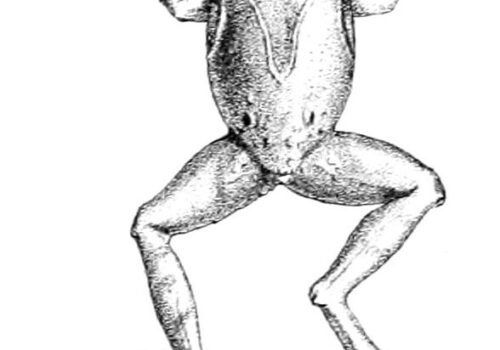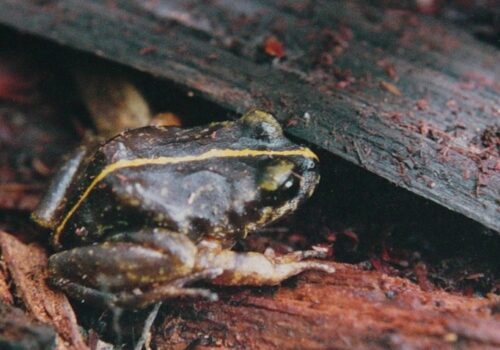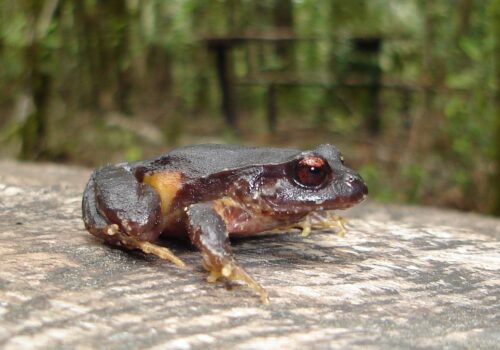- Taxonomy and Classification: Meet the Family Allophrynidae
- Natural Habitat: Dancing Among the Leaves
- Physical Characteristics: Nature’s Tiny Jewel
- Behavior and Life Cycle: Echoes of the Night
- Ecological Role: Harmonies in Rainforest Ecology
- Threats and Conservation Status: Protecting a Precious Jewel
- Cultural and Scientific Significance: Beyond Biological Curiosity
- Conclusion: Safeguarding Splendor
In the humid embrace of the neotropical rainforest, beneath a canopy buzzing with life, a small jewel-like amphibian lurks quietly—a creature as mysterious as it is striking. This glittering gem, known scientifically as Allophryne resplendens, captivates biologists and nature enthusiasts alike, not only because of its rarity, but due to the mesmerizing coloration and subtle behaviors that earn its name. “Resplendens,” meaning splendid or shining, perfectly conveys the charm and allure of this beguiling frog species found hidden amid the understory leaves.
First officially described only relatively recently, this splendid amphibian evokes curiosity, raising as many questions as it answers. What secrets lie hidden in the life and ecology of Allophryne resplendens? How does it contribute to the rhythm of the endangered rainforest ecosystem it inhabits? Join me on a fascinating journey through its cautious existence, resonant calls, cryptic behaviors, and explore how conservationists might protect this alluring gem of biodiversity.
Taxonomy and Classification: Meet the Family Allophrynidae#
Allophryne resplendens is a notable member of the relatively obscure family, Allophrynidae—a group primarily represented by a small number of enigmatic and often elusive frog species. Its closest known relative, Allophryne ruthveni, was discovered long ago but shed little light on the family’s greater secrets due to its own rarity and remote locality. Indeed, the discovery of resplendens added joyous complexity to taxonomists’ understanding of the group.
Initially discovered in Peru’s richly biodiverse Loreto region, Allophryne resplendens was formally described in 2013 by herpetologists Castroviejo-Fisher, Pérez-Peña, Padial, and Guayasamin. Genetic analysis has confirmed its distinctness from closely related species, clarifying its evolutionary trajectory and reinforcing its place within the fascinating tapestry of amphibian diversity.
Natural Habitat: Dancing Among the Leaves#
Like a precious gemstone hidden amidst endless greenery, Allophryne resplendens resides chiefly within the verdant lowlands of the northwestern Amazon basin, in remote areas of Peru, Ecuador, and neighboring regions. This region, blanketed densely with primeval rainforest, hosts countless undiscovered species, yet none as compellingly cryptic as this tiny amphibian.
Rather selectively, the splendid tree frog chooses habitats dominated by primary rainforest, characterized by moisture-laden understories and heavy leaf litter. Arboreal by nature, these frogs prefer perching on leaves or branches near slow-moving streams or swampy areas, favoring proximity to clean freshwater essential for breeding and tadpole development.
Imagine creeping silently into this world. Your boots sink into moist soil laced with decaying vegetation, and the air is thick, perfumed with blossoms and rich humus. Streams babble softly nearby, and every step reveals hidden treasures: jewel-winged insects, shadowed orchids, mysterious calls echoing overhead. Here is home to A. resplendens, cleverly concealed in plain sight. Its choice of habitat is belief reinforced by its cryptic coloration, perfect for surviving, feeding, and reproducing undetected.
Physical Characteristics: Nature’s Tiny Jewel#
A mere glance at Allophryne resplendens explains its enticing name: its body sparkles with a subtle brilliance seen nowhere else. Adults are small, typically measuring between 23 to 30 millimeters in length, their modest size masking tremendous biological complexity. They glisten vividly in iridescent shades of green and gold, flecked gently with soft bronze highlights—a cascading shimmer reminiscent of delicate rainforest silks.
The dorsal surface of this beguiling amphibian showcases tiny bumps, creating a rough texture that remarkably resembles the surface of leaves upon which it perches. Its flattened fingers and toes, each ending in circular adhesive pads, enable superb gripping power, essential for their arboreal lifestyles. The eyes, prominent and large, catch the faint moonlight and reflect a luminous glow as these nocturnal creatures navigate the darkness.
This intricate blend of subtle adaptations—from cryptic coloration and texture to brilliantly efficient foot pads—equips it masterfully to evade predators and secure its livelihood within the challenging ecosphere of its forest home.
Behavior and Life Cycle: Echoes of the Night#
Dusk settles gently upon the South American rainforest, cloaking the trees in deepening shadow. Amidst rustling leaves, the resounding chorus of nocturnal birds and insects fills the thick evening air. Suddenly, a gentle yet resonant chorus chimes in—”chirrrriii, chirrrriii.” This is the ethereal call of the male Allophryne resplendens, aiming to attract a mate through a gentle yet constant serenade.
Though many aspects of its breeding habits remain shrouded in scientific mystery, current evidence strongly suggests the species breeds during the wet season when freshwater pools and streams proliferate amid seasonal rainfall. Females carefully lay small clusters of gelatinous eggs adhering gently along the leaf margins near still waters or attached to submerged vegetation. In due time, tiny tadpoles hatch, quickly diving beneath the surface, where they will feed and mature hidden safely from watchful predators.
Adult frogs eat primarily small invertebrates: hunting insects at night, navigating the labyrinthine branches above ground with quiet precision. Predators lurk constantly—snakes, birds, and larger amphibians—each hungry pair of eyes combing the leaves for movement. Yet the splendid frog’s secretive habits and effective camouflage remarkably mitigate these threats.
Ecological Role: Harmonies in Rainforest Ecology#
The presence of Allophryne resplendens serves as more than mere beauty; as tiny as they are, these frogs fill vital ecological roles. By preying upon countless insect species, they help maintain balanced populations, controlling insect pests naturally and curtailing disease vectors. Conversely, these frogs themselves form important prey items for higher-level predators, providing necessary nutrition that sustains the intricate food webs upon which rainforest diversity depends.
Moreover, amphibians often serve as bio-indicators, their sensitivity to ecological change such as pollution, climate shifts, and habitat loss, making them the proverbial “canary in the coal mine.” Thus, the ongoing presence and survival of A. resplendens signals overall ecosystem health, a silent guardian overseeing conservation’s success outcomes.
Threats and Conservation Status: Protecting a Precious Jewel#
Despite its enchanting attributes, Allophryne resplendens faces notably increasing pressures. Although official conservation classification is still pending—largely due to a paucity of field data—researchers consider this species vulnerable to similar threats facing amphibian biodiversity worldwide. These threats include substantial habitat degradation via deforestation, agricultural expansion, logging, mining, chemical pollution, and climate variability altering rainfall patterns and water availability.
Organizations actively engaged in conservation efforts (for a broader look into amphibian conservation, visit our detailed guide on Global Amphibian Conservation Challenges) advocate protection strategies that preserve patches of pristine rainforest habitat and promote ecological resilience. Continued research efforts, enhanced habitat protection, and strengthened public commitment may ensure A. resplendens thrives amidst the Amazon’s biodiversity.
Cultural and Scientific Significance: Beyond Biological Curiosity#
Though not yet greatly embedded in human culture, this species represents important scientific frontiers. Ongoing discoveries regarding its behavior, ecology, and adaptive traits reveal remarkable evolutionary processes and offer potential biomedical insights. Amphibian skins often harbor fascinating compounds potentially useful in medicinal developments; thus, protecting frogs like A. resplendens secures potential future human benefit (explore amphibians’ medicinal potential further in our article about Frogs and Human Medicine).
Conclusion: Safeguarding Splendor#
The dazzling character of Allophryne resplendens showcases beautifully the delicate, interconnected nature of life within tropical ecosystems. Protecting this tiny hero ensures the sustained health, richness, and resilience of its native forest home. Thus, fostering awareness around such dazzlingly beautiful yet vulnerable species helps advocate preservation efforts, inspiring nature lovers and conservationists to commit ever more strongly to the worldwide cause of biodiversity conservation (How You Can Help Protect Rainforest Frogs).
May the quiet call of this splendid frog forever echo within its wild forest sanctuary, reminding each of us of nature’s worth, beauty, and enduring mystery.





